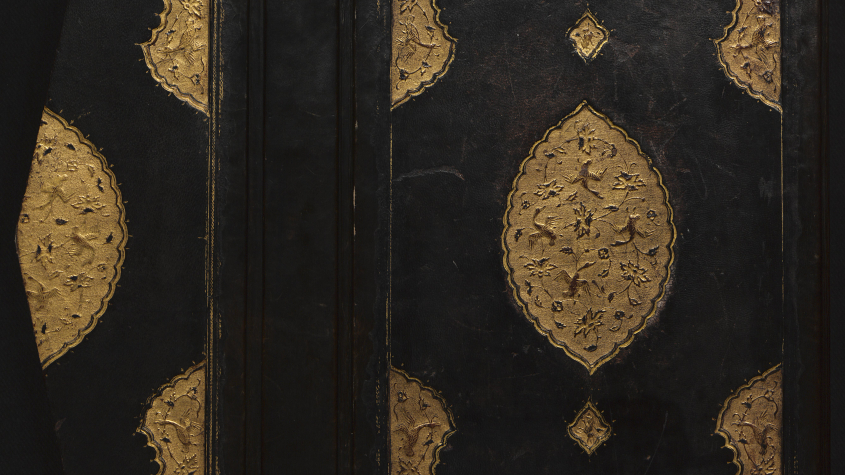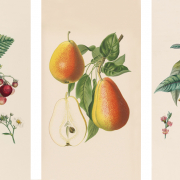An Authentic Example of Illustrated Shahnama: Ms. or. fol. 4255 in the Oriental Department of Staatsbibliothek zu Berlin
Gastbeitrag von Derya Aydın
Introduction
Being the most important work of Iranian literature and history, Shahnama was written by Abu Al-Qasim Firdausi (ca. 940 – 1020) in the early 11th century. Written in the form of masnavi, this work consists of 60,000 couplets. However, the number of couplets may vary in the extant manuscript copies of this work.
Shahnama begins with the creation of the first human and the universe and then narrates, in epic form, the wars, victories and loves of the sovereigns and heroes of the civilizations that used to live in Iran in the period from the Pre-Islamic period to the end of the Sassanid Empire (A.D. 226 – 651). Containing many mythological elements such as monsters (“div”) and dragons, these stories are generally known as heroic stories. The tradition of oral storytelling that used to exist in pre-Islamic Iran and works written before Shahnama – some religious texts related to Iranian history, epics – form the source of the stories that constitute Shahnama.
Shahnama became very popular in the course of time after it had been written. Thanks to this popularity, illustrated copies of it came up, and the stories that constitute the book were illustrated by the most skilful artists of each era. . It is accepted that the version of Shahnama which had been written by Firdausi and presented to Mahmud of Ghazni contained no illustrations. The date when the first illustrated version of it was made is not exactly known. The earliest-known manuscript copies of Shahnama date back to the early 14th century. After the first illustrated examples of this work in the 14th century, more manuscripts of Shahnama were produced, and their prodcution became a tradition in the course of time. The influential art patrons and sovereigns of the era that ordered the books played the most effective role in beginning and continuing this tradition. Even, for the sovereigns that exerted dominance over Iran and its surroundings, possession of the illustrated Shahnama strengthened their dominance over the region, and it became also an important instrument that gave them authority. Accordingly, there are many copies of illustrated Shahnama from various centuries in the manuscript collections of museums and libraries across the world. It can be accepted that most of these copies, if not all of them, were produced for a powerful patron.
The manuscript Ms. or. fol. 4255 and its characteristics
In the Oriental Department of Staatsbiliothek zu Berlin, which has an important collection of manuscripts, there are copies of illustrated Shahnama from various centuries. One of these copies is Ms. or. fol. 4255 , dating from the year 1489. The work dates back to the late 15th century, in other words, to the Turkoman era when the Qaraqoyunlu (1351-1469) and Aqqoyunlu (1340-1514) states had dominance over Iran and its surroundings. Considering the binding, illumination, script and especially illustration style of the book, it is accepted that the work could have been produced in Shiraz in the era of Aqqoyunlu dominance. It is possible to find some more information on the work. Unfortunately, there is no information about for whom the book was prepared. The colophon of the book tells that its calligrapher was Shams al Din Ali b. Muhammed b. Husain al Fakhr din al Fashtaqi al Kirmani (Fig.2).

Fig. 2: Colophon of Ms. or. fol. 4255 (fol. 317v), Oriental Department of Staatsbibliothek zu Berlin / Staatsbibliothek zu Berlin-PK – Lizenz: CC-BY-NC-SA 3.0
Also, there are notes on the first (6r) and last (317r) pages of the book stating that the book belonged to Sultan Abdülmecid (1839-1861), an Ottoman Sultan. Some stamps which can be found on the pages give us clues about the adventure of the book in the Ottoman Empire and make it possible to find out about the circulation of the book after its production (Fig.3).

Fig. 3: Note and Ottoman Stamp (Ms. or. fol. 4255, Ausschnitt von fol. 6r), Oriental Department of Staatsbibliothek zu Berlin / Staatsbibliothek zu Berlin-PK – Lizenz: CC-BY-NC-SA 3.0
Ms. or. fol. 4255 has some similarities with other illustrated Shahnama examples dating back to late 15th century, but also specific characteristics. Firstly, the dimensions and outer design of the book are attracting attention. The book made in the dimensions of 26 x 36 cm is larger than other Shahnama copies prepared in the same era. . Its outer design includes a gold-bronze medallion on black leather binding in angled form (Fig.1). In respect of its binding design, this copy displays features much admired in its era, and it has a distinctive place in terms of its dimensions.
The cover of the book is followed by an illuminated heading page (1v) and illuminated pages organized as double pages (5v-6r). These illuminated patterns include gold-bronze embroidered flowers on a dark-blue background so as to appeal to the taste of the 15th century.
Besides the outer design and illuminated ornamentation of the book, the pages and their design constitute the special character of the book. The page layout which had been preferred in manuscripts especially since the early 15th century was laying-out texts in four columns on a page. In Ms. or. fol. 4255, the text is laid out in six columns. Such a layout is seen more in the manuscripts which were prepared in the early 14th century. However, the use of six columns in this copy is an indicator and example that such application was chosen in the late 15th century, as well.
The layout of the text on the page in this way surely affected the position of the text on it. The page layout which was preferred in most of the illustrated manuscript examples of Shahnama from the 15th century was, except some different applications, laying out the text above and the illustrations below, the illustrations thus narrating the mentioned story. This application is slightly different in Ms. or. fol. 4255. The narration of the story goes forward with the text above and the illustrations below, as it was preferred. However, the six-column design caused the text to continue on the sides of the illustrations, as well. The event narrated by the text surrounds the illustration, and hence text and illustration complement one another. Thus, the story was narrated to the reader as a whole consisting of text and illustrations.
Nonetheless, not all illustrations in the book were made in this design. Different designs were tried for the layout of the illustrations on the page. It is another characteristic of this copy that some stories, especially those narrating the struggles between heroes and continuing one another, were illustrated in a three-layered form. It was intended, by illustrating subjects in this way, to enable to follow the story (Fig.4).

Fig. 4: A: The Combat: Giv and Guruy; B: The Combat: Siyamek and Guraza; C: The Combat: Zanga kills Akhvasht (Ms. or. fol. 4255, fol. 130r), Oriental Department of Staatsbibliothek zu Berlin / Staatsbibliothek zu Berlin-PK – Lizenz: CC-BY-NC-SA 3.0
Another application was encountered while examining the illustrations. Some illustrations go beyond the page limits (frames). Especially the illustrations placed on the bottom corner of the page continue by exceeding the page limits, which can be interpreted as the effort to illustrate the subjects or as the painter’s preference. However, it is one of the distinctions, in terms of design, in the book. The illustrations that complement the text were prepared in a way that reflects the style of the era when they were made. Mostly, a plain natural landscape, figures made with a certain pattern and gold bronze as well as plain colours draw attention to these illustrations. The number of illustrations in the book that have these characteristics cannot be underestimated. 87 of the stories in the book were illustrated. In respect of the abundance of illustrations, Ms. or. fol. 4255 is outstanding among the illustrated examples of Shahnama, which also makes this a comprehensive work of high quality.
Ms. or. fol. 4255 is one example among the illustrated copies produced in the late 15th century. Considering the design and illustration style of the book and its proprietor’s preferences as well as its calligrapher’s and painter’s contributions, this book is a work that incorporates the applications preferred in the illustrated examples of Shahnama produced in this era.
Principal Sources:
Robinson, B. W. (1991). Fifteenth- Century Persian Painting. Problems and Issue. New York and London: New York University Press.
Robinson, Basil W., (1979). The Turkmen School to 1503. The Arts of the Book in the Central Asia, 14th- 16th Centuries. (Ed: Basil Gray ), Shambhala, pp. 179-215.
Grabar, O. and Blair, S. (1980). Epic Images and Contemporary History: The Illustrations of the Great Mongol Shahnama. USA: University of Chicago Press.
Simpson, M. S., (1979). The Illustration of an Epic. The Earliest Shahnama Manuscripts. Garland Publishing, New York and London.
Warner, A.G. and Warner, E. (1910), The Shahnama of Firdausi, (repr.2000, 2002), Great Britain: Routledge.
Frau Derya Aydın, Ankara, war im Rahmen des Stipendienprogramms der Stiftung Preußischer Kulturbesitz im Jahr 2018 als Stipendiatin an der Staatsbibliothek zu Berlin. Forschungsprojekt: „Shiraz Atelier and the Illustrated Manuscripts of the Shahnama (Book of Kings)“

 CC-BY-NC-SA 3.0
CC-BY-NC-SA 3.0
 Photo: Lukáš Kubík
Photo: Lukáš Kubík


 https://creativecommons.org/licenses/by-sa/4.0/
https://creativecommons.org/licenses/by-sa/4.0/ Public Domain
Public Domain

Ihr Kommentar
An Diskussion beteiligen?Hinterlassen Sie uns einen Kommentar!